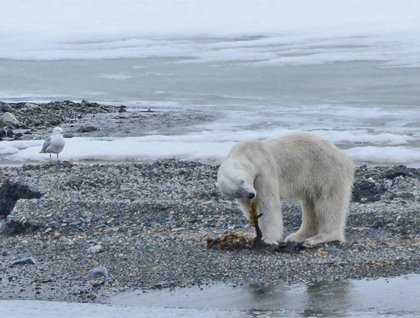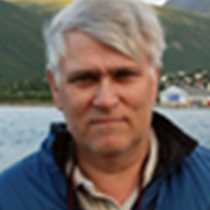The famous Norwegian explorer Amundsen stated “Adventure is just bad planning.” In his case maybe the goal was to survive and achieve a successful expedition. We are instead well-supplied with a great infrastructure and are well fed on board National Geographic Explorer. For us adventure is searching for the magical wildlife and scenery you find here at one of the most northern archipelagos in the world. At the northern tip of Svalbard you are only 540 nautical miles to the North Pole.
Already, yesterday, before we had cast the lines and left the pier, our sharp-eyed Captain Oliver Kruess spotted a female walrus with her calf swimming in front of the bow. Great start to our adventure.
We departed the old mining town of Longyearbyn and set sail for the southernmost major fjord along the western side of the main island of Spitsbergen, Hornsund. As we entered the fjord early in the morning dovkies, thick-billed murres, and a few harps seals greeted us. Slowly we made our way deeper into the fjord as our expedition leader Bud Lehnhausen introduced us to Svalbard rules and regulations. Of course everybody wants to see a polar bear up close, but it also creates issues regarding how we can land and walk around in the landscape. A hungry bear is not anything we want to encounter ashore.
Soon we had made it into one of the fjord arms, towards Samarinbreen (breen = glacier) and again our sharp-eyed captain spotted a yellowish spot in the water. Our first polar bear!
Soon everybody was gathered on the bridge, on the top deck, and at the bow as we were in good distance of a bear swimming. Later, after a short visit to the glacier front, we spotted the bear on our way out of the fjord arm and soon it decided to leave the water and walk along the beach. Now we were able to see it in full size, a very hungry, older, male bear.
As Hornsund did not have any fast ice throughout the winter, this is not a good place for a seal eating top predator to be. As we followed the bear walking along the beach front we saw it eating seaweed, not a very blubber-rich diet for a polar bear. Summers can be a hardship for a polar bear, which is designed to be on the ice to hunt seals.
During lunch the ship was repositioned to Gnålodden, a huge sea bird colony and also a great place to find Arctic fox. As we went ashore for some hiking on our first landing, everybody was rewarded with fantastic fox sightings. The Arctic fox in most of the Arctic survive through summer on lemmings but these are not to be found here in Svalbard. Instead the fox here have adapted to live on birds through the summer, and as winter arrives they escape out on the sea ice to become a scavenger, following behind the polar bears to pick up the remains of any kill.
At Gnålodden we were also able to get some bits and pieces about the Svalbard history. Remains of the Pomor period from 1700 to 1850 can be found together with a trapper’s cabin tied to the Norwegian period 1900-1970. In fact the Norwegians are the latecomers to arrive into the area, succeeded by the early whalers from Holland and England and the Russian Pomors. Since 1925 Svalbard has been under Norwegian jurisdiction, an outcome made during the Versailles conference in 1920, the Svalbard Treaty. The Norwegian flag was raised in Longyearbyn August 14, 1925.
Before dinner we set the course for the eastern islands and by tomorrow we will encounter new adventures at Edgeøya.
Before dinner Captain introduced his senior officers and soon it was time to catch some sleep in the endless daylight. Nights here at these latitudes are not dark. Darkness does not return until late August. Just adjusting to 24 hours of daylight is itself an adventure.







